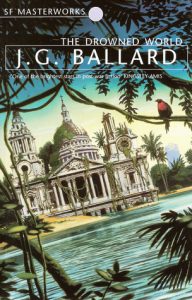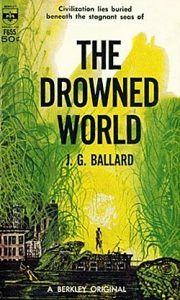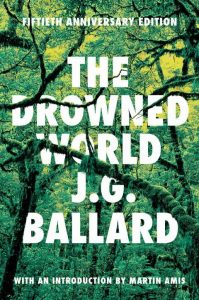THE DROWNED WORLD by J. G. Ballard (BOOK REVIEW)
 Ballard’s debut novel The Drowned World was published in 1962 after he had already enjoyed some years of success with short stories. In a later interview with Travis Elborough, Ballard attributed his relatively late transition to novel writing to the “huge (1950s) market for short stories, which doesn’t exist today” and he was grateful for the way that short story apprenticeship helped him to learn the craft and realise his strengths and weaknesses. There is certainly a short story aesthetic to The Drowned World, a fondness for enigma and imagery and key themes more so than a sense of plot or character. There are places where Ballard’s protagonist Kerans’ queries his own motivations, for example when he wonders why he stole a brass compass from a storeroom, and one feels Kerans is only echoing Ballard’s uncertainty. Why did I make him do that? What am I going to do with it?
Ballard’s debut novel The Drowned World was published in 1962 after he had already enjoyed some years of success with short stories. In a later interview with Travis Elborough, Ballard attributed his relatively late transition to novel writing to the “huge (1950s) market for short stories, which doesn’t exist today” and he was grateful for the way that short story apprenticeship helped him to learn the craft and realise his strengths and weaknesses. There is certainly a short story aesthetic to The Drowned World, a fondness for enigma and imagery and key themes more so than a sense of plot or character. There are places where Ballard’s protagonist Kerans’ queries his own motivations, for example when he wonders why he stole a brass compass from a storeroom, and one feels Kerans is only echoing Ballard’s uncertainty. Why did I make him do that? What am I going to do with it?
In a 1963 article (Time Memory and Inner Space, in The Woman Journalist) Ballard observed that “the great value of fantasy as a literary form is its ability to bring together apparently unconnected and dissimilar ideas.” In The Drowned World, Ballard certainly rises to that self-set challenge as he weaves themes of global warming (including its corollaries of sea level rise, climate change, worldwide diaspora and apocalypse) with ideas of de-evolution and hardwired neuronic memories inherited at birth.
In a near future world flooded by abrupt catastrophic warming, Ballard’s protagonist Kerans is a scientist within a military expedition on an extended survey mission through the drowned lands. When we meet him, the team have been holed up over the sunken remnants of an old city which it later transpires is London – Leicester Square to be more specific. The team flit around tropical lagoons formed between the protruding husks of old skyscrapers and Kerans himself has set up home in the Penthouse suite of the old Ritz Hotel. The call to action comes with the news that the expedition will shortly be moving away North to rejoin the remnant of civilisation near the arctic circle in Byrd camp. Kerans feels impelled to stay, harbouring an ambition to move south into the sweltering heat as the military move north. As he and two companions dally a while longer, narrative tension arrives in the form of a crew of scavengers led by Strangman set on either salvage, or looting depending on your perspective. Strangman and Kerans are soon in conflict about the direction individuals and humanity as a whole should be taking.
 Ballard’s training was in science – he studied medicine for two years – and he said “I do think that novelists should be like scientists.” At the thematic level Ballard uses a broad brush of science to paint his dystopian future. The sudden global warming and sea-level rise has triggered a process of de-evolution where the flora and fauna regress towards forms of species that last existed in a previous sun-baked period in the Earth’s existence, the Triassic. Ballard’s characters are confronted with a choice, whether to embrace or evade this regression, to head North to the shrinking habitable zone and try to recreate some echo of the flooded civilisations of central Europe, or to head south on an unknown journey into evolution’s past, a physical journey “back to the future.”
Ballard’s training was in science – he studied medicine for two years – and he said “I do think that novelists should be like scientists.” At the thematic level Ballard uses a broad brush of science to paint his dystopian future. The sudden global warming and sea-level rise has triggered a process of de-evolution where the flora and fauna regress towards forms of species that last existed in a previous sun-baked period in the Earth’s existence, the Triassic. Ballard’s characters are confronted with a choice, whether to embrace or evade this regression, to head North to the shrinking habitable zone and try to recreate some echo of the flooded civilisations of central Europe, or to head south on an unknown journey into evolution’s past, a physical journey “back to the future.”
To guide his characters on their way Ballard feeds in another motif, the notion of genetic memory haunting the characters in dreams of pasts their species have experienced. This was a popular theme in science fiction of the period, with the film Quatermass and The Pit and the TV show Dr Who and the Silurians both featuring characters traumatised by triggered dormant memories of creatures and events from millions of years before they were born. However, Ballard falls into a similar trap that these share with other narratives of prehistory such as the infamous Raquel Welch 1966 film vehicle “1 million years BC.” That is to say, their logic falls foul of the massive timescales involved and impossibility of humans overlapping with other species or eras. Ballard says “I also felt very strongly at the time I wrote The Drowned World that all of us carry, coded into our nervous systems, these archaic memories of the world that our ancestors grew up in thousands of years ago, a time when the climate was so much more dramatic.” However, the first recognisable humans – emerging some 70,000 years ago were creatures entirely of the quaternary era – a time of frequent deep glaciation relieved by brief 10,000 year periods of relative warmth. The Triassic period, with its steaming jungles, which Ballard eagerly invokes had ended 240 million years earlier when the dinosaurs’ dominance was still nascent. Notwithstanding the fascination with which Ballard overlays different times and periods over his flooded city setting, he strains the scientific verisimilitude in his pursuit of the metaphysical.
As Martin Amis in his introduction observes, the sweltering flooded vista that Ballard conjures in The Drowned World is not intended as a warning of the consequences of man-made climate change. Ballard’s super-heated earth has been warmed by a bloated sun straying way beyond its normal parameters in a way that would gladden the hearts of many climate change deniers. However, Ballard deserves credit for presenting climate change – real heating – alongside the rising sea levels. Much is made of the overworked air-conditioning units and noon temperatures of 130 degrees Fahrenheit and hence the conversion of London into a tropical jungle interspersed with lagoons.
However, these incredible temperatures border the limits of survivability, presenting a challenge that Ballard dismisses perhaps too lightly with references to growing sweat patches and Kerans’ own belief that his body through regression is somehow adapting to this harsh environment as though in an ongoing metamorphosis. It is alarming to see a former student of medicine have a story that appeals to what one character admits is “Lamarckism in reverse” to justify mutation and adaptation within generations – rather than Darwinian evolution between generations. Ballard uses this scientific sleight of hand to allow all species (man included) to rapidly regress into earlier forms in a “nightmare world of competing organic forms returning rapidly to their Paleozoic past.” That mechanism serves Ballard’s tale of a single individual against the environments of both man and nature. However, it could be contrasted with Adrian Tchaikovsky’s Children of Time which takes a more Darwinian approach to evolution and adaptation, while still managing to preserve a character focus within his many generations of evolving arachnids.
 Ballard’s cry that “each one of us is as old as the entire biological kingdom, and our bloodstreams are tributaries of the great sea of its total memory” is at once interesting yet also misleading in attributing a function to the genetic codes of DNA that they do not carry. The degree to which we are impressed by the skills of new born foals to walk is not a matter of inherited learning, so much as wiring – neuronal connections built before birth as an evolutionary imperative that the swaddled and carried human babies never needed. It is Tchaikovsky again in Children of Ruin who introduces the concept of an entirely different kind of architecture to genetic material, a kind that can be self-aware, part virus part Star-Trekian Borg, and which hungers to go an adventure even as it takes over and destroys the lives and memories it assimilates. It is left to Ballard’s Strangman to condense the notion of genetic memory and Kerans’ dream filled journey through “archeopsyhcic time” in a pithy comment “You know, Kerans, leaving the sea two hundred million years ago may have been a deep trauma from which we’ve never recovered.”
Ballard’s cry that “each one of us is as old as the entire biological kingdom, and our bloodstreams are tributaries of the great sea of its total memory” is at once interesting yet also misleading in attributing a function to the genetic codes of DNA that they do not carry. The degree to which we are impressed by the skills of new born foals to walk is not a matter of inherited learning, so much as wiring – neuronal connections built before birth as an evolutionary imperative that the swaddled and carried human babies never needed. It is Tchaikovsky again in Children of Ruin who introduces the concept of an entirely different kind of architecture to genetic material, a kind that can be self-aware, part virus part Star-Trekian Borg, and which hungers to go an adventure even as it takes over and destroys the lives and memories it assimilates. It is left to Ballard’s Strangman to condense the notion of genetic memory and Kerans’ dream filled journey through “archeopsyhcic time” in a pithy comment “You know, Kerans, leaving the sea two hundred million years ago may have been a deep trauma from which we’ve never recovered.”
Ballard makes use of depth as a metaphor for time and a descent into the water as a journey into the past of both the individual and the species. When Strangman encourages Kerans to use a diving suit to travel into the waters of the lagoon, he warns him “But don’t try to reach the Unconscious, Kerans; remember it isn’t equipped to go down that far!” Kerans instead finds himself in the old London planetarium viewing a different pattern of constellations laid out by light penetrating random chinks in the old dome and again pursuing the theme of seeing a past “Perhaps the very configuration of constellations that had encompassed the Earth during the Triassic period.” From the depths of the lagoon, Kerans sees Strangman on the surface as existing in a “single plane of time… so transparent as to have a negligible claim on reality.” In that notion of superimposed existences occupying a single space and so accumulating significance and reality Ballard makes the lagoon into a chronotope of somewhat spiritual significance.
When Strangman elects to pump out the lagoon in order to facilitate the salvage (looting) of the old submerged department stores and jewellery shops, this creates a tension for Kerans. Strangman is seeking to reaffirm the present’s dominance over the past. Ballard elides a number of significant practical difficulties around draining so large an area, or even the value of any submerged treasures that could be recovered. The ultimate conflict is not simply between Kerans and Strangman, but between those seeking to flee north and preserve vestiges of the present – maybe even reclaiming some of the drowned lands – and those embracing Ballard’s de-evolution and aspiring to journey south into an unknown past or future.
While Ballard’s distraction with “archaic memories… coded into our nervous systems” speaks less emphatically to modern science, his vision of a flooded world and sweltering climate is persuasive. His background as a child in flood vulnerable Shanghai and a Second World War Japanese internment camp inspired much of the imagery of The Drowned World. As Ballard said “coming from a very dramatic part of the world, a place with war, floods and all the rest of it, I’ve always felt that people living in the cosy suburbia of Western Europe and America never appreciated just how vulnerable we were to climatic disasters.” It is incumbent on climate change literature to continue to puncture that complacency.


[…] were an excellent way for a writer to learn his craft. This fantastic and more detailed review at Fatasy Hive also discusses the Travis Elborough […]
[…] possible big changes that could sweep the world—JG Ballard’s novel The Drowned World (1962) [review] seems prescient now, as one example of climate change fiction. Heavy Weather by Bruce Sterling […]